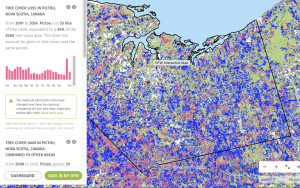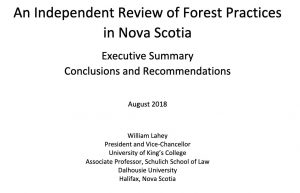UPDATE NOV 17, 2021: From the notice sent to subscribers from Forestry Maps, received today (bolding inserted):
The Harvest Plan Map Viewer has been updated today Monday, November 17, 2025…
The next update is scheduled for Thursday, November 27, 2025. Please note the review timeframe has been reduced to 20 days.
The purpose of the Harvest Plans Map Viewer is for the public to share local information…
Reminder – We are now posting licensees’ development plans on the Harvest Plans Map Viewer for comment for 40 days. These plans outline their proposed harvest operations for the coming 12 months. Harvest proposals that are not included in a development plan are posted for comment for 20 days.
If you share specific information about the site of a proposed harvest...
COMMENT: The first set of plans under this new scheme cites “proposed” harvests for a Total of 624 ha, those in Antigonish, “Cape Breton”, Colchester, Guysborough, Halifax & Hants Counties, all with 20 day reviews. So these are, apparently, “Harvest proposals that are not included in a development plan”. See Nov 17th and earlier listings under Recent Harvest Plan Notices on this website for details and to view the recent reduction in review periods.
Post-Lahey, transparency of and public participation in, management of the Wabanaki/Acadian forests on public lands are being reduced, not increased as called for by Lahey.
| Conclusion # 143: I have instead concluded that forestry on Crown lands should be governed by a forest management planning process under which “FULA holders” will be required to develop a forest management plan for the lands they are to manage through a Class II environmental assessment under the Environment Act or a process under the supervision of an independent third party that emulates such an environmental assessment. In either case, there should be a written report to the deciding minister or ministers and a decision with supporting written reasons from the minister or ministers. The requirement for such plans developed through a public process is a level of forest management on Crown lands – required in other jurisdictions – that is missing in Nova Scotia. It is a level that should be instituted however forestry is to be conducted on public lands, but it is especially important if Nova Scotia is serious about conducting ecosystem‐based forestry on a landscape basis. Other provinces use environmental assessment, or a process like environmental assessment, to conduct this level of planning, including using it as a vehicle to facilitate the public’s participation in forestry at a strategic planning level. Doing so in Nova Scotia under the authority of the Minister of Environment creates an opportunity to bring transparency and accountability to the process and to mitigate the concerns about how DNR internally manages its competing responsibilities. |
The next conclusion #144 begins “The other opportunity created by such a process is to reduce DNR’s micromanagement of forestry on Crown lands. It would do this by making it clear that the industry is responsible for conducting forestry, including silviculture, in accordance with a forestry management plan transparently developed with public participation through a process overseen by an independent third party, not DNR or industry…”
The actions of DNR illustrate how they are cherry picking what they/Big Forestry like from the Lahey conclusions and recommendations and ignoring what they don’t, and then claim that the Lahey Recommendations have been implemented.
Obviously there is discontent on the side of those who have campaigned for more ecologically oriented forest management in Nova Scotia. Big Forestry in turn smarts at any criticism and harps on how it is the victim of people/groups it portrays as anti-forestry, anti-forest workers, re: recurring themes in Forest NS’s Forestry Uncut Podcast series.
For those of us who have participated in good faith in two rounds of NS Forest & Forestry Reviews/Recxmmendations since 2008 under governments led by the NDP, Liberals and now PCs, it’s a familiar trajectory. So here we are 7 years after the Lahey Report was tabled apparently en route to repeat the process again. Surely we can do better.
—–
ORIGINAL POST, Nov 6, 2025
Received today, bolding inserted:
 The Harvest Plans Map Viewer has been updated as of November 6, 2025. No proposed harvest plans were added. Please see the map at: https://nsgi.novascotia.ca/hpmv/ The Harvest Plans Map Viewer has been updated as of November 6, 2025. No proposed harvest plans were added. Please see the map at: https://nsgi.novascotia.ca/hpmv/
The next update is scheduled for November 17, 2025.We are making changes to how harvest proposals are reviewed and approved. Starting this fall, licensees will submit development plans that outline their proposed harvest operations for the coming 12 months. The majority of their proposed work on Crown land will be captured in these plans. Sometimes they may have individual proposals outside of these plans. The development plans will be posted on the Harvest Plans Map Viewer for comment for 40 days. If your comment provides information about the proposed harvest plan that is specific to the site, you may be contacted for further detail. Harvest proposals that are not included in a development plan will be posted for comment for 20 days. These changes streamline the planning process while still keeping an avenue open for people to provide local knowledge about the sites being proposed for harvest. It’s one way that we’re supporting our forestry industry to sustainably manage forests on Crown land, create jobs for Nova Scotians and bring more than $2 billion a year into our provincial economy.We thank you for your interest. |
COMMENT (David P)
Evidently this “streamlining” is a further step in DNR’s ‘selective adaptation’ of the Lahey Report, one recommendation of which was:
# 20: The forestry management planning process for Crown lands should be conducted under a legislated environmental assessment process, either as a Class II environmental assessment under the Environment Act or in a process that emulates the Class II process under the supervision of an independent third party (or panel) under the authority of the Minister of Natural Resources or the Ministers of Natural Resources and Environment. This process should be required before the issuing or renewal of forest utilization agreements.
The benefits of this process were cited under Conclusion # 78 (bolding inserted)
| # 78. A legislated forestry management process conducted as a Class II environmental assessment – or in a comparable process under an independent third party (or panel) – has the potential to accomplish a range of objectives: a. It will bring transparency to the management of Crown land for forestry production and provide the public with a meaningful opportunity to contribute to Crown land management at a strategic level of decision making. b. It will help to ensure that forestry is conducted on Crown lands in ways that are compatible with the full range of values applicable to the management of public lands, with the activities of other users of Crown lands, and with activities taking place on neighbouring lands. c. It will help to embed the principles and values of ecosystem‐based forestry (or of ecological forestry) into the plans that will then inform operational planning and harvesting decisions. d. It will bring a significant measure of institutional independence from DNR to the planning of forestry on Crown land. e. It will create opportunities for stronger and continuing relationships between operators and their stakeholders and mechanisms for ongoing dialogue with those stakeholders through the process of a plan’s ongoing implementation. f. It will facilitate and enable customized application of the principles of ecosystem‐based forestry to account for relevant regional differences. g. If done properly, with openness and transparency and based on strong science, it will reduce the pressure for intense scrutiny by DNR or the public of individualized harvesting decisions. |
Also apparently tacitly dropped by DNR is Prof Lahey’s recommendation related to Western Crown Lands, which while not necessarily being conducted under a FULA, would involve “a legislated forest management planning process” (p. X) and “the same Class II environmental assessment process” (Conclusion #136, p 52).
The Environmental Assessment process was to include a Forest Stewardship Plan; it would, among other functions, ensure that “landscape-scale concepts are attended to and looked after from a sustainability point of view”*
*See Biodiversity Landscape Planning for Nova Scotia is being developed as part of the L&F Environmental Assessment Project 16Jun2020
Otherwise, there is no evident Landscape Level Planning for Biodiversity Conservation going on at DNR and clearly DNR wants to limit public input to “local knowledge about the sites being proposed for harvest”.*
*Note under (a) above, the EA would “provide the public with a meaningful opportunity to contribute to Crown land management at a strategic level of decision making“.
Even in that regard, however, by requiring that all plans for 12 months ahead are reviewed within 40 days, DNR is greatly compressing the time for natural history-0riented individuals/groups familiar with a particular region to document, for example, occurrences of Species-at-Risk within particular sites.
As commented by Nina Newington,
“Lahey’s triad model is a tradeoff…[but] The bargain is not being kept.”
Nor are the priorities.
My mandate was to make recommendations on forest practices that would, if implemented, balance environmental, social, and economic objectives, which I have interpreted to include values. My conclusion is that environmental, social, and economic values should be balanced by using forest practices that give priority to protecting and enhancing ecosystems and biodiversity.
…A number of reasons are given for this conclusion, but the primary reason is that ecosystems and biodiversity are the foundation on which the other values, including the economic ones, ultimately depend. – Lahey, p. iii
Some related posts, pages

An example of why a priority on enhancing ecosystems and biodiversity is appropriate in 2025: Figure illustrates Forest cover loss (red) and gain 2002-2025 in Pictou Co. (from Global Forest Watch). Most of the loss was associated with clearcutting 2002-2024; most of the gain was in lands clearcut before 2002.
– 40 days and 40 nights to comment on 5-year PHP harvest plans under Nova Scotia’s Outcomes Based Forest Management
David Patriquin, post on NSFM Aug 4, 2024
– Geoff Hurley on “A Balanced Path” for Nova Scotia
Geoff Hurley, Post on NSFM 7Mar2025
– Addendum: On the EA
Page on this website, posted Aug 5, 2024
– Shady Accounting and Vanishing Forests on Nova Scotia’s Crown Lands
Nina Newington, Post on NSFM 14Jul2024
– Why was the Port Hawkesbury Paper FULA not preceded by an EA or equivalent process?
David Patriquin, Post on versicolor.ca/nstriad 1Feb2023
– A Letter Worth Reading, Part 2: Of goshawks and safeguards in Nova Scotia
Nina Newington, Post on NSFM 15May2025
– Nova Scotia Goverment responds to Questions about the Sustainable Forest Harvest Level
David Patriquin, Post on NSFM 16oct2024




